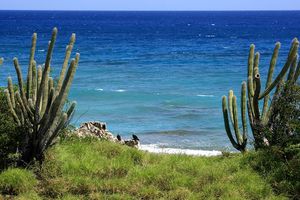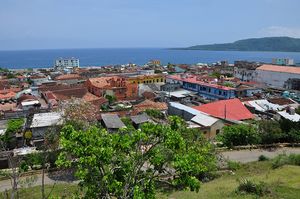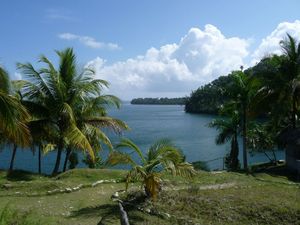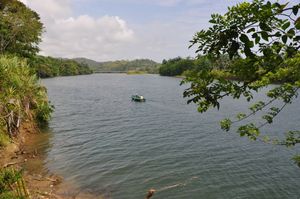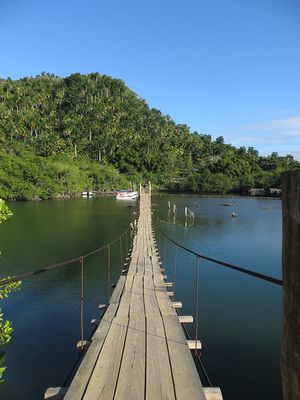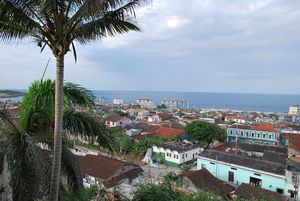

Guantánamo, Cuba
Visit Guantanamo, a beautiful province of Cuba that hides valuable natural, historical and cultural jewels
The province of Guantánamo, the easternmost province of Cuba, for around 400 years was an isolated area of the island, which could only be reached by sea. Inside you will find three world heritage sites, which makes it the province with the largest quantity on the island.
Its location has made this province a true natural paradise, as it has exotic virgin beaches such as Playa Duaba, Playa Mapurisí or Playa Maguana; fascinating perfectly preserved natural reserves such as the Parque Nacional Alejandro de Humboldt (Alejandro de Humboldt National Park), Boca de Yumurí or El Yunque; beautiful cities founded since the 16th century by the Spanish, such as the famous colonial town Baracoa and Guantánamo.
In turn, Guantanamo is known for the establishment of the controversial US Naval Base in the town of Caimanera in 1902. Apart from the existence of the famous facilities, Caimanera has beautiful and impressive places to enjoy unforgettable vacations.
On your tour of this province, be sure to visit the old colonial city of Baracoa, the Ciudad Primada. Its splendor makes it one of the most visited, highlighting the sculptural fortifications that protect it (Matachín Fort, La Punta Fort or the Seboruco Castle).
Currently, the communication infrastructures are good in this province, since it has two airports and the Viaducto de La Farola (La Farola Viaduct), an authentic work of Cuban engineering that provides easy access to Guantánamo.
Visit one of the most important and unknown areas of Cuba, discover its interesting history and the beauty of its nature that gives life to this wonderful place.
Index:
- What to see in Guantánamo?
- What are the best trips to take in Guantánamo?
- Where to stay in Guantánamo?
- How to get to Guantánamo, Cuba?
- When to visit Guantánamo?
What to see in Guantánamo?
Guantánamo, the “land between rivers” offers a wide variety of plans and places to visit. Much of its destinations are characterized by the unique natural beauty that surrounds them, without neglecting the important history that composes them.
Its capital, the City of Guantánamo, is a large city full of color and life. Its colonial style is a representation of the Spanish and French influence of the time and the importance it had at that time due to its commercial activities in sugar cane, coffee and cotton.
Among the places to visit, the following stand out: the Tumba and los Cafetales Franceses (the French Coffee Plantations), both World Heritage Sites and clear representatives of the Afro-descendant culture in Cuba. Another is the Catedral Santa Catalina de Ricci (Santa Catalina de Ricci Cathedral), which presents a heritage architecture from the 19th century that adorns the historic center of the city.
In the east of the province is Baracoa, with an important role in history, as it was the first Spanish settlement on the island. Founded in 1511, it was declared a National Monument for its perfectly preserved natural and historical wealth.
Territory found by Columbus himself, it houses the Cruz de la Parra, an authentic cross brought by the admiral and still preserved in the Parroquia Nuestra Señora de la Asunción (Our Lady of the Assumption Parish). In addition, the city presents archaic buildings such as three forts (Matachín Fort, La Punta and the Seboruco Castle) that once protected the important city.
Its natural wealth is unmatched throughout the island, as it has two world heritage sites: Parque Nacional Alejandro de Humboldt (Alejandro de Humboldt National Park) and the Reserva de la Biosfera Cuchillas del Toa (Cuchillas del Toa Biosphere Reserve) that constitute a treasure of endemic fauna and flora for Cuba. In turn, its fabulous landscapes are complemented by El Yunque and the paradisiacal beaches with crystalline waters that adorn a large part of the Baracoa coast.
The easternmost point of the island is known as Punta de Maisí, a spectacular place if what you are looking for is to learn a little more about the island's aboriginal traditions and culture. You will be able to explore coffee plantations, see fascinating marine terraces, navigate through a beautiful well with crystal clear turquoise waters: Pozo Azul (Blue Well) and of course, a majestic lighthouse, the origin of the Spanish settlement, built in the 19th century.
To the south of the province you find Caimanera, the closest point to one of the most disparate areas in all of Cuba, with an abundant natural and archaeological wealth. The situation so close to the naval base that the United States has had there since 1903 can undoubtedly arouse the curiosity of many people, although it must be understood at all times that it is not a tourist destination that can be visited. However, this town offers much more landscape, and you will find amazing semi-desert territories (Tinajones) or a wonderful ecological reserve (Hatibonico).
What are the best trips to take in Guantánamo?
In Guantánamo you will find enough excursions to dazzle you with the nature that it is filled with.
It is advisable to spend several days in Baracoa since, in addition to visiting the beautiful city, you will find excursions to the Reserva de la Biosfera Cuchillas del Río Toa (Cuchillas del Río Toa Biosphere Reserve), a fascinating ecological paradise declared a Natural Heritage of Humanity. Located in the Sagua-Baracoa massif, it represents one of the most important centers of endemic fauna and flora on the island.
Within this reserve and with the same title as Natural Heritage of Humanity, you will find the well-known Parque Nacional Alejandro de Humboldt (Alejandro de Humboldt National Park), a unique natural treasure throughout the island with several routes to enjoy the important biodiversity that composes it. The fauna and flora found in this park represents one of the greatest places of endemism in the world, without a doubt a privilege that the island possesses.
The reserve also includes the illustrious Parque el Yunque (El Yunque Park), which is home to an anvil-shaped rock formation, which has become a symbol of the city of Baracoa. In this splendid park you can explore both dense forests and fascinating cocoa and coconut fruit crops, and you will have the possibility to enjoy a refreshing swim in a waterfall of turquoise waters or an adventurous Jeep tour.
You will find other parks such as Majayara and Yumurí, in which in addition to the fantastic views and beautiful nature, you will find an important cultural value. In Majayara you can enjoy speleology and appreciate important aboriginal petroglyph carvings. In Yumurí, in addition to splendid viewpoints, you will find the Nengón and the Kiribá festivals, traditional Afro-descendant dances from the area.
In Punta de Maisí, the easternmost tip of Cuba, you can enjoy natural excursions to delight yourself with the impressive marine terraces and the splendid Pozo Azul (Blue Well). It has considerable archaeological wealth, since it was an important place of development of the Taino culture. A day trip can be organized, although if you prefer you can spend a couple of nights there and enjoy nature and the sea.
Visiting Caimanera has become a more crowded destination, but not just for trying to spot the US Naval Base. Within this town you will find protected natural areas such as the Reserva de la Biosfera de Baconao (Baconao Biosphere Reserve). In this is the Reserva Ecológica de Hatibonico (Hatibonico Ecological Reserve), which has a semi-desert landscape with rock formations commonly known as Monitongos. You can choose a one-day excursion from Guantánamo to Caimanera, but if you prefer, you can also make plans to spend a few days there and enjoy what this fabulous town has to offer.
Although Guantánamo is more attractive due to its nature, it is also an ideal place to visit its paradisiacal beaches and enjoy a well-deserved rest. You will have the pleasure of being able to choose between nearby beaches such as Playa Miel and Manglito; more private and relaxing ones like Mapurisí, Nava, Cajuajo or La Fundadora beaches; one with interesting black sands and historical importance: Duaba beach; and some with fine white sands and crystal clear waters such as Playa Blanca and Maguana.
Where to stay in Guantánamo?
In Guantánamo, as in the rest of Cuba, staying in a private house is without a doubt an experience like no other. This option will take you into the culture and you will enjoy living the Cuban lifestyle first hand. In addition to the warm welcome that the locals will give you, you will enjoy having tips and recommendations of places to see, eat or activities to do from people who know the region perfectly.
But, if you prefer, there are also a series of hotels and ecological hostels where you can enjoy Guantánamo.
In the capital you will find the Hotel Guantánamo, a comfortable hotel with a Caribbean colonial style with a refreshing pool; the Hotel Martí, a pleasant hotel in the historic center of the city; the Hotel Brasil, an old renovated building in the center of the city with a Brazilian style; Villa La Lupe, a fantastic hotel with pools and comfortable cabins on the outskirts of the city.
In Baracoa you will find the Hotel Plaza, a cozy restored hotel in the historic center of the city; the Hotel Baracoa, a beautiful hostel recently renovated with a spectacular view of the sea. The famous Hotel El Castillo, former Seboruco Castle, is a magnificent hotel with a swimming pool and an excellent view of the bay; and the Hotel Porto Santo, a heavenly hotel on a hill facing the sea, is ideal for a perfect rest.
If you are looking for a slightly cheaper option and more in the city center, you can find Hostal Río Miel, a comfortable hostel with a beautiful view of the sea; Hostal 1511, a unique hostel in a cozy colonial house; the Hostal La Rusa, a pleasant hostel with beautiful views of the sea; and the Hostal La Habanera, a beautiful inn with a perfect location, next to the historic center and a few meters from the sea.
If you are looking for accommodation surrounded by fascinating nature, you can select the option of ecological hostels such as Campismo El Yunque (Camping El Yunque), a comfortable campsite in the El Yunque Natural Park located right next to the Río Duaba (Duaba River); Finca La Esperanza, an authentic place to connect with nature, where you can enjoy the surroundings in a traditional way; Campismo Duaba (Camping Duaba), a colorful campsite also very close to the Duaba River and the Cascada de Baracoa (Baracoa Waterfall).
In Maisí you can find the Hotel Faro de Maisí, a colorful hotel remodeled for a pleasant stay in the town; and the Villa Punta de Maisí, a wonderful hostel with a refreshing pool and a beautiful view of the lighthouse and the sea.
In Caimanera you’ll find the Hotel Caimanera, a beautiful hotel with a swimming pool adorned with slender Caribbean palms.
How to get to Guantánamo, Cuba?
To get to Guantánamo you have different options that fit your travel style and budget. The first of them, rare, is on a yacht, by which you can visit the region arriving from Porto Santo in the Bahia de Baracoa (Bay of Baracoa).
Another alternative, a bit more common among travelers, is by plane. Guantánamo has two national airports (Mariana Grajales Airport in the city of Guantánamo and Baracoa Airport in Baracoa). Despite being one of the most expensive options, it is without a doubt one of the best, since the distance from Havana is significant, making it an ideal option to make the most of your time on the island.
You can rent a car or hire a taxi (private transfer), and the central highway gives you the possibility to go from Havana to Guantánamo in no less than 12 hours, although it must be taken into account that the journey to cross the island is from its west to its easternmost end. If you enjoy the freedom of driving and want a tour of the different provinces of Cuba, renting is a good option, although it is generally expensive. If you prefer to save those hours of driving to better enjoy the landscape and even save yourself a little time, it is advisable to use the private transfer, which in turn can serve to receive valuable information in situ.
One of the cheapest options is the Viazul, a bus that runs through the different provinces with specific stops. It is one of the options that takes the longest since there is no direct bus route to Guantánamo. The tour will be around 20 hours from Havana.
When to visit Guantánamo?
You can enjoy visiting this region throughout the year, although if you like culture and want to enter it in a more intimate way, you cannot miss the following events:
Enjoy the Fiesta a la Guantanamera (Guantanamera Festivities) from December 1 to 4, a cultural celebration in which the different provinces and even some invited countries participate. Activities are carried out to promote and preserve Cuban cultural values.
Visit the region during the Festival Nacional del Changüí Elio Revé Matos (National Festival of Changüí Elio Revé Matos), a festival that takes place every 2 years from May 30 to June 4. It is a lively party that brings together important personalities of Cuban music and culture, where the indigenous rhythm of the Changüí is mainly celebrated.
Enjoy the Guantanamo and Baracoa Carnivals, the most anticipated parties of the year by locals. Between typical music, costumes and floats, there is a unique atmosphere. The Carnaval de Guantánamo (Guantánamo Carnival) is celebrated in the hot month of August and the Carnaval de Baracoa (Baracoa Carnival) is celebrated at the beginning of April.
The Semana de la Cultura Guantanamera y Baracoense (Guantanamera and Baracoense Culture Week) is one of the most important cultural celebrations for the people of Guantanamo. Some of the traditions of the region are enjoyed with joyful dances, beautiful artistic manifestations and craft fairs. Guantánamo is held in the last week of February and Baracoa is held the last week of March.
You can also visit Baracoa during the Fiesta de las Aguas, a festival between August 10 and 15, where the anniversary of the city is celebrated. Among the cultural activities the traditions of the old town are celebrated.
Interactive map:
Guantánamo
What to see:
- City of Guantánamo
- Martí Park
- Plaza del Mercado Market Square
- Policarpo Pineda Rustán Library
- Plaza Mariana Grajales Square
- Punta de Maisí
- Boca de Yumurí
- Baracoa
- Catedral de Nuestra Señora de la Asunción
- Seboruco de Santa Bárbara Castle
- El Yunque
- Alejandro de Humboldt National Park
- Río Toa
- La Farola Viaduct
- Zoológico de Piedras
Beaches:
Museums:
Other nearby destinations:
Why "Trip Cuba"?
Trip Cuba is an organization of Cuban agencies whose objectives are:
- ✓ To make Cuba, its culture and its heritage known.
- ✓ To promote sustainable tourism.
- ✓ To support the local economy, prioritizing direct contact with Cuban agencies.
Travel Agencies
If you are a travel agency or tour operator and you are looking forward to any assistance or collaboration to plan trips to Cuba, rely on our extensive experience
Copyright www.TripCuba.Org © - All rights reserved
All our agencies are duly registered in the National Registry of Travel Agencies of the Chamber of Commerce of the Republic of Cuba.







